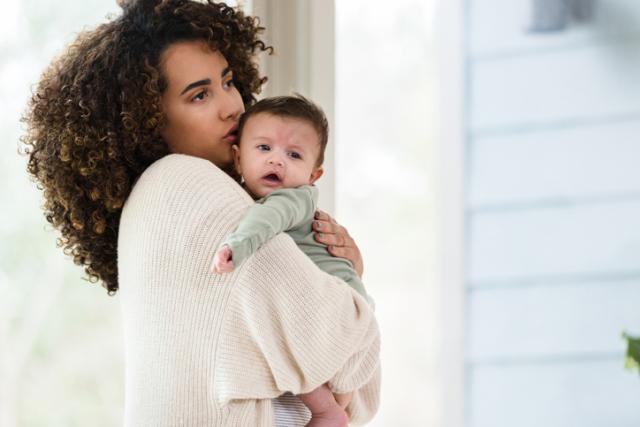Antibiotics target bacteria and do not fight viral illnesses like colds. Taking antibiotics when they are not the right medicine can be harmful to your baby and older child's health and can even make future infections harder to treat.
Parents have many questions about the use of antibiotics to treat their sick baby or older child. Here are answers to some common questions from the American Academy of Pediatrics (AAP).
My baby has a really bad cold. Why won't the doctor prescribe an antibiotic?
Most colds are caused by viruses. Antibiotics are used specifically for infections caused by bacteria. In general, most common cold symptoms—such as runny nose, cough, and congestion—are mild and your child will get better without using any medicines.
Many young children, especially those in child care, get six to eight colds a year.
Do some colds turn into bacterial infections? So why wait to start an antibiotic?
In most cases, bacterial infections do not follow viral infections. Using antibiotics to treat viral infections may instead lead to an infection caused by resistant bacteria, which are harder to treat. Also, your child may develop diarrhea or other side effects which may be dangerous.
Is a nose draining yellow or green mucus a sign of a bacterial infection?
During a common cold, it is normal for mucus from the nose to get thick and to change from clear to yellow or green. Symptoms often last for 10 days.
There are certain signs that bacteria may be involved: if your child has a common cold with cough and green mucus that lasts longer than 10 days; if your child has thick yellow or green mucus and a fever higher than 102°F for at least three or four days; or facial pain with fever. These may be a sign of bacterial sinusitis. Before an antibiotic is prescribed, your child's doctor will ask about other signs and examine your child to make sure an antibiotic is the right medicine.
Are antibiotics supposed to treat ear infections?
Not all ear infections are treated with antibiotics. At least half of all ear infections go away without antibiotics. If your child does not have a high fever or severe ear pain, your child's doctor may recommend observation at first.
Because pain is often the first and most uncomfortable symptom of ear infection, your child's doctor will suggest pain medicine to ease your child's pain. Acetaminophen (Tylenol) and ibuprofen (Motrin) are over-the-counter pain medicines that may help reduce much of the pain. Be sure to talk to your child’s doctor and use the right medicine and dose for your child's age and size. In most cases, pain and fever will improve within the first one to two days.
Over-the-counter cold medicines (decongestants and antihistamines) don't help clear up ear infections and are not recommended for young children.
Your child's doctor may prescribe antibiotics if your child has fever that is increasing, more severe ear pain and infection in both eardrums.
Are antibiotics used to treat all sore throats?
No. More than 80% of sore throats are caused by a virus. If your child has sore throat, runny nose and a barky cough, a virus is the likely cause and a test for "strep" is not needed. Antibiotics should only be used to treat sore throats caused by group A streptococci "strep throat." Strep throat generally affects school-aged children and rarely children younger than 3 years. If your child's doctor suspects strep throat, a strep test should always be performed to confirm. If an antibiotic is needed, it is important that your child use the antibiotic that is most specific for your child's infection rather than an antibiotic that would treat a broader range of infections.
Do antibiotics cause any side effects?
Side effects from antibiotics can occur in one out of every five children and may include rashes, nausea, diarrhea vomiting and stomach pain. Make sure you let your child's doctor know if your child has had a reaction to antibiotics in the past or has any symptoms that concern you.
Sometimes a rash will occur during the time a child is taking an antibiotic. Not all rashes are considered allergic reactions. Tell your child's doctor if you see a rash that looks like hives (red welts) soon after taking the first dose of an antibiotic—this may be an allergic reaction.
What are antiviral medicines?
Influenza (flu) is a viral infection that can cause cold symptoms for which an antiviral medicine will work. An antiviral medicine may be prescribed for children that are at higher risk of becoming severely ill if they get the flu. For most other viruses causing cough and cold symptoms, there are no antiviral medicines that work or are recommended.
How can I use antibiotics safely?
- Make sure that you give the medicine exactly as directed.
- Don't use one child's antibiotic for a sibling or friend—you may give the wrong medicine and cause harm.
- Keep antibiotics and all medicines locked up securely.
- Throw away unused antibiotics. Do not save antibiotics for later use—some out-of-date medicines can actually be harmful.
Speak to your child’s pediatrician if you have any questions about antibiotics. They can answer all questions or concerns you may have.
The AAP does not recommend retail-based clinics, telehealth services outside of the medical home or acute care services without pediatric expertise for children younger than two years.
From the American Academy of Pediatrics:
- Why Most Sore Throats, Coughs and Runny Noses Don’t Need Antibiotics
- Medication Safety Tips for Families
Call (866) MY-LI-DOC (866-695-4362) to find a Catholic Health physician near you.



